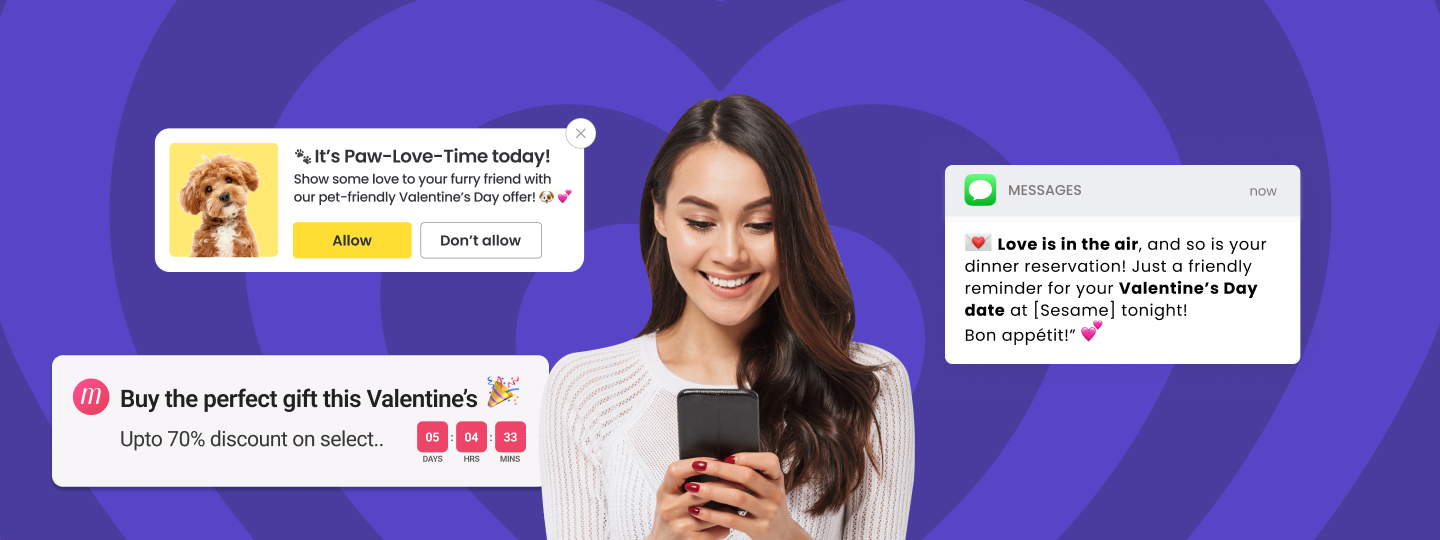Table Of Contents:
1. How do you measure customer retention for E-commerce store?
2. Retention is not engagement and vice versa
3. The inevitable case of E-commerce customer abandonment (and how to fix them)
4. Page abandonment
5. Search abandonment
6. E-commerce cart abandonment
7. [Bonus] Pro tip to improve e-commerce retention- Mix transactional emails & recommendation engine
8. How to do that?
In e-commerce, a user completes the transaction on his own without intervention from any sales personnel or equivalent. There is no learning involved, like a B2B sale, and the purchase happens almost on impulse. Furthermore, to a user, there are plenty of choices, so he can just hop to another store and complete the transaction there.
What it essentially entails is that in e-commerce, it is difficult to retain users. On the other hand, with numerous low-cost channels, facebook and retargeting platforms available, raking in users is relatively easier.
That could partly be the reason behind marketer’s obsession with acquisition but indifference towards creating retention goals. This report from Adobe has some interesting stats to share:
- In the US, 40% of revenue comes from returning or repeat purchasers, who represent only 8% of all visitors (for equivalent European data see Appendix tables).
- Marketers in the United States and Europe must bring in 5 and 7 shoppers, respectively, to equal the revenue of 1 repeat purchaser.
- Most of the revenue improvement in purchaser segments can be attributed to increased conversion rates which are up to 9 times those of shoppers.
- Repeat purchasers account for even more revenue during the holiday season and times of slow economic growth.
A higher number of returning users tells way more about your product than an equal number of new users.
Retention has more intrinsic and business value than acquisition.
In this post, we are going to discuss how fixing user abandonment can significantly contribute to retention. But before we proceed further, let’s solidly conclude the definition of ‘Retention’.
How do you measure customer retention for E-commerce store?
Retention is the measure of the user’s revisit to the product. Higher the retention, higher the frequency of users returning to your product.
Better retention is atypical of product that commands a good product-market fit- which is basically the ultimate objective of every business.
To quantify and observe the retention rate of users over the span of time, say a month or week, we create a cohort chart.

With cohort chart, you can take a variable say ‘number of users completing a purchase in a given month’ and see how it changes over a period of time, giving you the trend of retention. If ‘Cohort Analysis’ is not your strong point then check out this post we published some time back that would give you the easiest understanding of cohort analysis and its business applications.
‘Cohort analysis as a feature is available in all enterprise level web analytics tool. If you don’t use any of them then you could opt for GA where a mild version of Cohort Analysis is available.
Retention is not engagement and vice versa
Most folks use retention and engagement interchangeably which is not technically right.
Retention is the measure of the user’s revisits to the product. It is a definite metric. Engagement, on the other hand, is a measure of user’s affinity towards your product. It is measured at the session level. It is indicated by metrics derived from user’s activity on the product like session length, number of goals completed, LTV etc.

Andrew Chen, Growth @Uber
“There’s an important distinction between engagement versus retention, which some folks often track in one bucket. I generally define retention is simply the act of getting users BACK to revisit, regardless of their actual activity on the site. Contrast this with engagement, which measures how much time they spend with the product, how many features they interact with, etc”. via http://andrewchen.co/
The contrary of retention is abandonment. Unfortunately, we don’t have the exact stat of abandonment in e-commerce. I came across a couple of stats on web but due to lack of data and dicey methodology, I am not mentioning them. (If you come across any credible source, please mention them below) However, speaking with our CSMs I concluded that it hovers around 70-90% depending on the category. (apparently, it’s the lowest among fashion retailers)
The inevitable case of E-commerce customer abandonment (and how to fix them)
Abandonment is one of the greatest challenge-cum-opportunities for e-commerce. Every retailer employs myriad methods, both on the UX and engagement side, to minimize user abandonment.
As a matter of fact, this is one of the first use-cases that they come to us with during the POC. I am referring to e-commerce and OTA players such as Flipkart, Zivame, Yatra, Makemytrip etc.
Now, if we go deeper we would find that abandonment branches into three separate use-cases
- Page abandonment
- Search abandonment
- Cart abandonment
Onwards, we would look at examples of couple of our own customers who ran journeys to re-engage users who were lost due to any of the above reasons.
1. Page abandonment
Page abandonment is a ubiquitous challenge. Since a majority of your MAU would be anonymous there would be no mean to bring them back except retargeted ads which would be bulldozed by ad blockers anyway.
The only medium available is onsite and web notification. Zivame, India’s largest Lingerie retailer, employed these two channels and created a journey to achieve an astonishing 20% uplift in conversion. You can read the case study here.

2. Search abandonment
The user who does the product search on your website or app has a clear intent of purchase. Obviously, it’s relatively easier to convert them in comparison to users who just randomly surf.
The ‘search abandonment’ equivalent in OTA is ‘booking abandonment’ where a user searches for the flight and leaves without making the transaction.
Goibibo created a journey that identified those users and sent a hyper-personalized retargeted email.
The email had various personalized elements constituted by the data sourced from external systems via API calls which got them an uplift of 11% in conversion. You can read the full case study here.

3. E-commerce cart abandonment
Cart abandonment is perhaps the world’s most popular use-case. Half of the internet is filled with ‘tricks’, ‘hacks’, ‘tips’ to reduce abandonment but we are not going to repeat any of them.
Let’s look at what PrettySecrets– one of India’s largest lingerie retailer and manufacturer did.
Excerpts from the case-study
They picked and tracked the following two critical events from the user checkout flow and checked for purchase upon their occurrence
- User reached payment page
- User added to cart
They created two separate journeys with the above events as the entry trigger respectively. Suppose, while purchasing, if the user triggers any of the above events but doesn’t complete the transaction then he is contextually nudged to do so by the corresponding journey.
The two journeys collectively led PrettySecrets to reduce abandonment by 7.3%.
[Bonus] Pro tip to improve e-commerce retention- Mix transactional emails & recommendation engine
Two quick points
- McKinsey had estimated that Amazon generated 35% of its revenue from recommendations alone. It spans across their entire UX and communication strategy. For an SMB it is practically impossible to replicate the Amazon’s recommendation strategy. We could still make some headway though.
- Transactional emails have the highest click-through/open rate for the obvious reason. But marketers still miss out on this opportunity
Incorporating recommendation in transactional email can have a drastic effect on the net conversion. Drew Sanocki, a former executive of streetwear retailer Karmaloop, claims that his company managed to generate $2 million additional revenue only by leveraging transactional emails to cross-sell.

Drew Sanocki, Former CMO, Karmaloop
Quick quiz: what’s the number one most opened email for any retailer?
Answer: the order receipt.
And yet most retailers neglect this obvious promotional mechanism
Playing around with your purchase receipts is a great way to get another purchase and increase overall purchase frequency. One tweak of the order receipt at Karmaloop generated over $2 million incremental revenue for us. via BigCommerce Blog
How to do that?
If you are running your website on a CMS then there are several apps that let you add products to cross-sell from the dashboard itself. Drew Sanocki in the same article suggests Conversio app for Bigcommerce.
There are various other products that let you do that. I have come across Retail Rocket which has also created a wonderful infographic on its website depicting the myriad use-cases of recommendation emails in chronological order.

There are also open source recommendation technologies that can help you code directly into your product.
Conclusion
All the methods that we have talked about so far are essentially the nudges to push user to complete the transaction. They are just a notification, albeit done correctly. But there is something to be said
Notification is not the answer to a bad product.
If you have a bad product that is not answering user’s needs then no amount of beautiful notifications with a super powerful copy can translate to success.
Notification is a compliment, not the solution. Treat it likewise.
Hope the ideas discussed in this post comes useful to you when you create or pursue your retention goals.
Bonus Read – 6 Best Practices For Customer Retention: E-commerce


































 Vanhishikha Bhargava
Vanhishikha Bhargava
 Diksha Dwivedi
Diksha Dwivedi
 Kasturi Patra
Kasturi Patra



